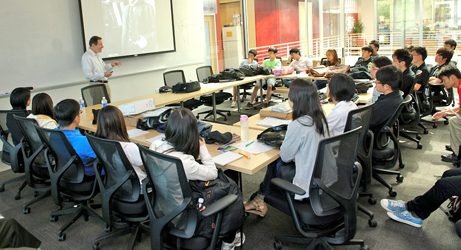Module: Our Guest Answers Your Questions
Saturday, April 21st, 2012
Imagine you’re in a school lecture: how likely are you to ask a question? Imagine you’re competing in a science fair: how likely are you to have prepared your presentation with the help of questions? Just what opportunities are there for youth to learn to ask questions and ask them well? Not many really. Youth are taught mainly to provide answers. But the skill of asking questions, especially creative ones, is critical for discovery, innovation and leadership.
In a university setting, creative questioning sadly does not become a significant opportunity until graduate school. So, one of the skills our youth program would like to impart to youth is thinking of and asking good questions. First, it would help to know what kind of questions are at one’s disposal:
(a) clarification – perhaps the easiest because it safely stays within current scope and can cycle on itself until full clarity is reached.
(b) extension or tangent – the question could suggest a further conclusion or further work. Ask if it is useful to the discussion.
(c) speculation or propositional – the question could suggest an alternate interpretation or conclusion that has yet to be supported. Some element of risk but potentially impressive. Demonstrates vertical thinking.
(d) connecting – the question could ask whether the topic at hand is connected to another topic that was not presented. Demonstrates lateral thinking.
(e) gap-filling – the question could ask about the existence of missing information or if/when a gap might be filled.
(f) philosophical – especially useful in data-driven communications is to look for the intangible forces behind a work. For example, ask who would benefit from a product or new knowledge, or how a paradigm might shift as a result of the new findings or strategies.
(g) critical – a difficult question to frame because of potential misunderstanding and conflict. Requires experienced questioning skill.
Now down to the practical application of this to a YCISL workshop. We could have a guest speaker prepare just a few minutes introduction or none at all. It would be entirely up to the audience of students to ask questions to drive the conversation. This is consistent with the desires to: (a) facilitate bi-directional flow of ideas and thoughts, (b) encourage students to discover by asking questions, (c) ease the pressure on speakers to formally prepare material or topics for their session, and (d) encourage spontaneity.
For this to work, we would need a good moderator. We might videotape such a session so the students can (a) review how they asked the question, (b) gauge the speaker’s reaction, (c) listen to the response elicited by the question, and (d) gauge the audience’s reaction to the resulting question-answer exchange.
And I should mention why I even considered such a module. It’s because I have observed how some students might not get connected with a speaker because (a) they are the silent type, (b) they are worried about how they will be perceived by their interaction, and (c) they are worried that their knowledge about the subject matter is novice and potentially annoying to the speaker. By putting the responsibility to drive the conversation on the students (and having a speaker who is open to questions), we can demonstrate to the students the importance of asking good questions.
